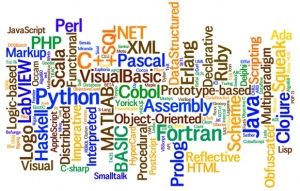 The "first and only" developer focused analyst firm RedMonk has recently published their ranking of programming languages as of January 2014. Let's see how the situation has changed since January 2013 and what're the languages to watch this year. It goes without saying that the better you understand current coding trends, the better you can plan your entire software development strategy.
The "first and only" developer focused analyst firm RedMonk has recently published their ranking of programming languages as of January 2014. Let's see how the situation has changed since January 2013 and what're the languages to watch this year. It goes without saying that the better you understand current coding trends, the better you can plan your entire software development strategy.
So, here's the comparison of Top 20 programming languages as of January 2013 and 2014, according to RedMonk:
|
January 2013 Check out a related article:
|
January 2014 |
|
|
As seen from the table above, the Top 3 languages remain the same for the second consecutive year and are JavaScript, Java and PHP. In spite of their vast differences in both design and usage, JavaScript and Java remain the focal languages for enormous mobile app developer communities worldwide. Regarding PHP development, it holds its 3rd position confidently enough, backed up by huge investments from Facebook and Zend as well as ubiquitously popular CMS and frameworks such as WordPress, Phalcon, Symfony2, etc.
This year, C# and C++ have improved their positions and both went up from the last year's ranking. This can be partly explained by the increasing demands for high-performance server and client applications and video games we're observing today.
As for the newcomers, we've got Clojure and CSS getting on the bandwagon this year. Clojure joins the Top 20 list for the first time since RedMonk began surveying programming languages. Although ThoughtWorks have put Clojure to this year's "Adopt" section of their Technology Radar (together with Scala), the fact it's got to the Top 20 Languages List proves current demands for Java Virtual Machine (JVM) based alternatives to be really high among developers. As such, code-as-data philosophy is likely to go mainstream in or after 2014.
In the Technology Radar by ThoughtWorks CSS is actually listed among the top leaders in the "Hold" section. It is indeed the core technology for building websites and mobile apps along with JavaScript and HTML and it seems weird it got to the RedMonk's List only in January 2014. The reason for this delayed acknowledgement may underlie in the following: as a language, CSS lacks some of the key features which results in a very high level of duplication and a lack of meaningful abstractions. Whereas CSS3 aims to fix some of these issues, it will take years for CSS3 modules to be supported in most browsers. However, such modern CSS frameworks as LESS, SCSS or SASS are able to eliminate the lion's share of handwritten coding, making the language itself more flexible and better applicable to modern software development environments.
Last year, Ukrainian online community of software developers conducted their own survey of programming languages popularity, and that's how their 2013 Top 20 looks like:
- Java
- C#
- PHP
- C++
- Python
- JavaScript
- Objective-C
- Ruby
- C
- ActionScript
- 1C
- PL-SQL
- Pascal/Delphi
- Perl
- Scala
- Groovy
- Basic
- T-SQL
- Erlang
- CoffeeScript
It's interesting to note that while the 2014 Ukrainian survey results are yet to be unveiled some day in the future, last year's Top 5 matched very closely this year's Top 5 by RedMonk!
And what're the languages to watch for 2014?
- Statistical programming languages such as R and MATLAB or Julia that will be used more extensively going forward given the rapid development of diverse Big Data technologies
- Alternative JVM languages such as Scala, Groovy, or Jython which are more agile and dynamic than Java
Would you continue my list? What languages seem to be most prospective to you?
Sources: RedMonk, 2014; ThoughtWorks, 2014; douua.org, 2013






